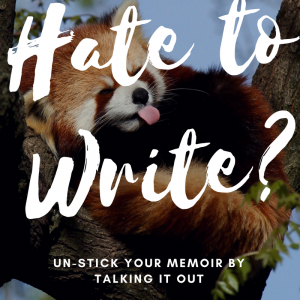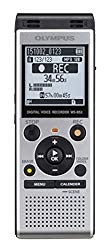 “I hate to write, how can I do this?” As I mentioned last week, this is a sticking point for some folks. They’re great oral storytellers but the thought of writing those stories and memories down gives them “test anxiety” at the least and “the screaming mimi’s” at the worst. Never fear-there are a few different ways to handle this, don’t let it stop you!
“I hate to write, how can I do this?” As I mentioned last week, this is a sticking point for some folks. They’re great oral storytellers but the thought of writing those stories and memories down gives them “test anxiety” at the least and “the screaming mimi’s” at the worst. Never fear-there are a few different ways to handle this, don’t let it stop you!
Solution 1—Talk out your story into a voice recorder
With the help of a handy little voice recorder you can just tell your story. Carry it with you, turn it on, record, pause or turn off till you’re ready to tell your next story, or continue with your thoughts. You can collect memories in a stretch of reminiscing over photos or with family. Or maybe just relate brief thoughts or impressions as they come to you throughout the day. Don’t worry that they’re not in order. That is the beauty of digital recording and computers. While it will save you some time and help you focus if you have a plan and go through your life story memories somewhat chronologically, it isn’t critical. Thanks to the beauty of downloading and cut and paste, your lovely, moving or humorous stories can be rearranged into whatever order you choose later.
Here’s how it works:
Purchase an inexpensive digital voice recorder. I have used an Olympus Digital Voice Recorder very similar to this one for years (some links on this site are affiliate links–I only recommend items that I either use myself or strongly believe to be helpful):

I show this tiny workhorse at workshops and folks repeatedly ask what model it is and where they can get one. There are many different brands out there in a range of prices. The Olympus model has been a great fit for my work and has had excellent reviews on quality, clarity and ease of use. It also lets me record in different files to keep projects separate. This makes downloading to separate computer folders even easier. The recorder runs on a two AAA batteries and has great battery life. I have found that Procell by Duracell batteries have excellent performance and reliability and have switched to using them exclusively in my work.
Another top rated recorder option is this one: SONY ICD PX333 Digital Voice Recorder
Both are high quality items that will do the job and serve you well. Whichever one you choose, based on features or price, they all work pretty much the same and will make telling your story easy and fun.
Keep the recorder with you, it will serve as your ever-ready personal assistant. Starting with the technique in the last blog post, go ahead and brainstorm your memories and story ideas into the recorder. Then, when thoughts come to you or you want to expand on some stories or reminiscence over visual prompts such as photographs, you’ll just talk your story out into the recorder. A recorder such as the Olympus holds about 24 hours worth of audio recording. I use mine regularly for interviewing and as an extra note-taker when I’m at meetings and need to be able to go back and fact check or review content. It will help you focus on the story and not on trying to write your notes legibly, a challenge for me, that’s for sure!
Later, when you’re ready to download your stories, just plug the recorder into your computer, transfer the files and you now have your oral history recording in a format that can be easily transcribed into written form. Voila, “test anxiety” gone!
Solution 2 – Team up with a friend to record each other’s stories.
Again, this taps into the power of oral story telling. It also adds in the fun of having a buddy to tackle the project together. Find a friend who is either interested in also telling their own story or is intrigued with you and yours. Remember, this is not a never ending time commitment nor a long term project. Getting these stories down will take a focused-10-12 hours of recording time, spread out over a handful of sessions. I’d recommend setting aside time once or twice a week for about a month. Of course, the beauty of this is that you can work around your own schedules.
Then, either use the voice recorder (I do recommend this as it helps you go back at your leisure and capture the full nuance of the story. For family members and friends, having a recording of your voice is a priceless addition to your story—why not do it?) Or, you can take turns with your friend, interviewing each other and taking notes on each other’s stories. This takes away your fear of a blank piece of paper, you just tell the other person’s story.
The fun of the buddy system will keep you both on track and accountable. A multi- strand cord is stronger, tag-teaming with a friend or another family member will help you both to succeed.
Thanks and Happy Story Telling!
Karen
(Karen Ray is a participant in the Amazon Services LLC Associates Program, an affiliate advertising program designed to provide a means for sites to earn advertising fees by advertising and linking to amazon.com.)
 The dusty, faded shoe box was crammed under the workbench. In the midst of de-cluttering fervor my friend said, “Take it home, I didn’t know it was there and I haven’t missed it.” I felt like the Indiana Jones of Garage Archaeology! It was a small memoir encased in cardboard; inside were a number of small items tucked into old jewelry boxes. But they weren’t just objects, each has its own story and some will be sent on to a family member.
The dusty, faded shoe box was crammed under the workbench. In the midst of de-cluttering fervor my friend said, “Take it home, I didn’t know it was there and I haven’t missed it.” I felt like the Indiana Jones of Garage Archaeology! It was a small memoir encased in cardboard; inside were a number of small items tucked into old jewelry boxes. But they weren’t just objects, each has its own story and some will be sent on to a family member.
